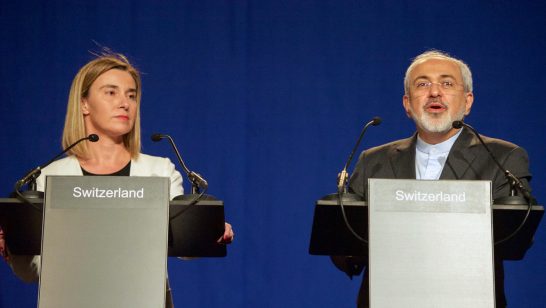
Moving up its annual naval exercise from the fall, including live-firing an intermediate range anti-ship missile,[1] the Iranian Islamic Revolutionary Guard (IRGC) deployed on August 2 as many as 50 Kalat, Houdong, Kaman, and Sina gun- and missile-boats to the Strait of Hormuz, which separates the Persian Gulf from the Gulf of Oman.[2]
The IRGC wished to demonstrate its ability to seal the strategic passage to international shipping with mines and “swarming” surface vessels. Despite Iran’s ability to temporarily close the strait, which sees the transit of approximately 30% of traded crude oil, Admiral (ret.) James Stavridis, former NATO Supreme Allied Commander, assured that the U.S. Navy is capable of quickly unblocking the waterway.[3]
However, the US Navy should not be left alone with the task. Maintaining freedom of navigation through this strategic waterway should be seen as important for Europe as well. Through NATO, it should contribute to the efforts by deploying a Standing NATO Maritime Group (SNMG) and a Standing NATO Mine Countermeasures Group (SNMCMG) in order to:
- Support freedom of navigation through the strait for commercial travel, free from threat of Iranian vessels and mines
- Work to minimize the risk of tensions spilling over into a larger regional conflagration with Saudi and the Gulf Cooperation Council coalition currently militarily engaged with the Houthis in and around Yemen
- Leverage NATO, as a multi-national platform, to inject a European voice of reason in order to keep the peace amid US-Iran tensions. This should be done in parallel with diplomatic efforts to revive the JCPoA
Supporting freedom of navigation and maintaining commercial shipping lanes is crucial for the stability of global energy markets, as recently evidenced in late June when Saudi stopped oil shipments through the Bab El-Mandeb Strait subsequent to Houthi attacks on two tankers there.[4] It would also help to ensure European economic stability, as OPEC oil composes 40%, and the Saudis 8%, of total EU petroleum needs annually.[5] According to OPEC, Iran, as the third-largest producer, exported 2.28 MMbpd of crude oil last June. In order to reassure the sensitive Brent Crude and West Texas Intermediate markets, King Salman bin Abdulaziz of Saudi declared that the Saudi spare production capacity is 2 MMbpd, stating that it is ready for “…use if and when necessary to ensure market balance and stability, and in coordination with its producer partners, to respond to any eventuality.”[6] But Iranian interference in the Strait of Hormuz would severely curtail the ability to transport oil from Ghawar in Eastern Saudi and Basra in Southern Iraq. Additionally, it would create a bottleneck at other transit routes, as Saudi, Iraq, and the UAE would be pushed to bypass Hormuz via the Iraqi Pipeline in Saudi (IPSA) crossing the Arabian Peninsula and the Habshan-Fujairah Pipeline connecting the UAE and Oman.
Deploying NATO’s naval forces to the Persian Gulf can aid in preventing both US-Iran and Saudi-Iran tensions from escalating, through the presence of rapidly deployable on-call maritime assets and their deterrence impact. Pairing deterrence with diplomatic leverage during any renewed dialogue on the future of the JCPoA would increase Europe’s chances of success as well as its international credibility.
A related question is whether European NATO assets can support the US military to counter any threat from Iranian asymmetrical tactics. An SNMG, consisting of a multi-national destroyer/frigate component, is perfectly suited for protecting shipping lines, while an SNMCMG’s mine hunters would be available to neutralize Iranian mines in the Strait. By sending NATO assets on a narrow mandate to protect sea lines of communication for all international shipping, the Alliance would free US naval assets to better counter Iranian forces if need be. But defining the mission as protection of shipping would also provide some push back against possible charges of siding with Trump on the Iran issue.
Deploying NATO maritime assets, beyond a simple addition of firepower, would signal that Europe will not accept hostile actions in the Gulf, nor any hostage-taking of its energy markets. It would furthermore be consistent with NATO’s four pillars of deterrence and collective defense, crisis management, cooperative security, and maritime security identified in its 2011 Alliance Maritime Strategy.[7] These assets, even deployed on a narrow mandate to protect sea lines of communication, would constrain Iran’s ability to force a confrontation with the Americans over a possible blockade, a development which would push them further from any renewed JCPoA negotiations; thereby, providing a deterrent against both dangerous escalatory measures by Iran and a restraint to any aggressive American reaction.
The recent Iranian show of force in the Gulf comes amid an exchange of threats between Presidents Trump and Rouhani[8], as well as ongoing hostilities between the Saudi-led GCC coalition and Iranian-backed Houthi rebels in Yemen. In naval warfare, just as in life, calmer heads prevail. Europe is uniquely positioned to lead by example here. But in order to do so, it must assertively engage the issue by bringing NATO’s naval assets to the region.
[1] Iran test fired anti-ship missile during drills last week.” Reuters. https://www.reuters.com/article/us-usa-iran-missile/iran-test-fired-anti-ship-missile-during-drills-last-week-u-s-source-idUSKBN1KV2FG
[2] Stewart, Phil. “Iran naval drills underway amid tensions with U.S.” Reuters World News. Accessed via: https://www.reuters.com/article/us-usa-iran-military/iran-naval-drills-underway-amid-tensions-with-u-s-idUSKBN1KN2R6
[3] The US has been developing maritime swarming countertactics since the Millennium Challenge 2002 joint war game, which exposed the Achilles heel of heavier, less maneuverable US surface battle groups. In the simulation, the US lost a dozen plus ships, thousands of sailors, marines, and airmen as a result of the asymmetric naval warfare tactic.
Typical U.S. naval armaments such as Tomahawk and Harpoon missile systems are multi-million dollar options that could prove too expensive to counter the far more inexpensive Iranian boats. Other options include the 30-kilowatt energy-weapon system currently installed aboard the amphibious ship, the USS Ponce deployed in the Middle East. Lasers, while not the only solution to Iranian swarming tactics, present a cost-saving option, but are less than perfectly effective in adverse weather conditions. Integrated Longbow Hellfire missiles, installed aboard US littoral combat ships, can fill the gap between the two. Navy tests of the Longbow Hellfire (identified as Guided Test Vehicle-1) against simulated swarms of fast-attack speedboats were reported as successful. Other systems, which would be layered to increased defensive depth against such swarming attacks, include onboard guns, SEARAM missiles, and MH-60 Sea Hawk helicopters.
Additionally, layered defenses could include a complement of fixed wing planes. The February 2018 combat exercises in Florida’s Choctawatchee Bay are an example of such an approach. These drills simulated dozens of swarming boats engaged by both A-10 Warthogs and Canadian CF-18 Hornets. Originally designed for close-in air support, A-10’s weapon systems afford the Warthog both versatility and relevance against naval targets. Having seen combat in Iraq, Afghanistan, and Libya, A-10 can prove its value against any Iranian show of force.
[4] Sheppard, David, Al Omran, Ahmed, and Raval, Anjli. “Saudis suspend Red Sea oil shipments after tanker attacks.” Financial Times. Accessed via: https://www.ft.com/content/f0858962-9005-11e8-b639-7680cedcc421
[5] European Commission. “Supplier Countries.” Reports. Accessed via: https://ec.europa.eu/energy/en/topics/imports-and-secure-supplies/supplier-countries
[6] “UPDATE 5-Saudi king said will boost oil output if needed – White House.” Reuters. Accessed via: https://af.reuters.com/article/africaTech/idAFL8N1TW0AW
[7] “Alliance Maritime Strategy.” NATO-OTAN. Accessed via: https://www.nato.int/cps/ic/natohq/official_texts_75615.htm
[8] @realDonaldTrump “To Iranian President Rouhani: NEVER, EVER THREATEN THE UNITED STATES AGAIN OR YOU WILL SUFFER CONSEQUENCES THE LIKES OF WHICH FEW THROUGHOUT HISTORY HAVE EVER SUFFERED BEFORE. WE ARE NO LONGER A COUNTRY THAT WILL STAND FOR YOUR DEMENTED WORDS OF VIOLENCE & DEATH. BE CAUTIOUS!” 16:18 PM – Aug 15, 2018
The opinions articulated above also do not necessarily reflect the position of the European Leadership Network or any of its members. The ELN’s aim is to encourage debates that will help develop Europe’s capacity to address pressing foreign, defence, and security challenges.



